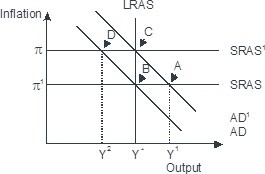Based on the figure below. Starting from long-run equilibrium at point C, a decrease in government spending that decreases aggregate demand from AD1 to AD will lead to a short-run equilibrium at__ creating _____gap.
A. B; no output
B. D; an expansionary
C. B; recessionary
D. D; a recessionary
Answer: D
You might also like to view...
Which of the following best illustrates the fallacy of composition? a. If I have more money, I will be better off; therefore if we all had more money, we all would be better off
b. If I buy more gas each week, my gas consumption increases; therefore, if all gas consumers buy more gas each week, total gas consumption will increase. c. If I spend more time studying, I will learn more; therefore, if all students spend more time studying, they will learn more. d. If women's hemlines are higher this year, the Dow Jones Industrials average will fall.
The difference between long-term and short-term profit maximization is that, in the short term,
A. businesses focus on achieving as much profit as they can, given that they can vary all inputs, even to the point of shutting down. B. businesses focus on achieving as much profit as they can, but in the long term, businesses always eventually shut down. C. businesses focus on achieving as much profit as they can, given that fixed costs cannot be changed. D. businesses are not able to maximize profits because they can vary all of their inputs, making the calculations too complicated.
Which of the following is true about monetary policy in the liquidity trap?
A. An expansion of the money supply will have the large effect of raising interest rates when the economy is in the liquidity trap. B. Monetary policy will be unable to reduce interest rates further to stimulate investment. C. The demand for money is interest-inelastic in the liquidity trap. D. The opportunity cost of holding money is relatively high at interest rates implied by the liquidity trap.
Consumer surplus is the difference between the most a person is willing to pay and market price.
Answer the following statement true (T) or false (F)